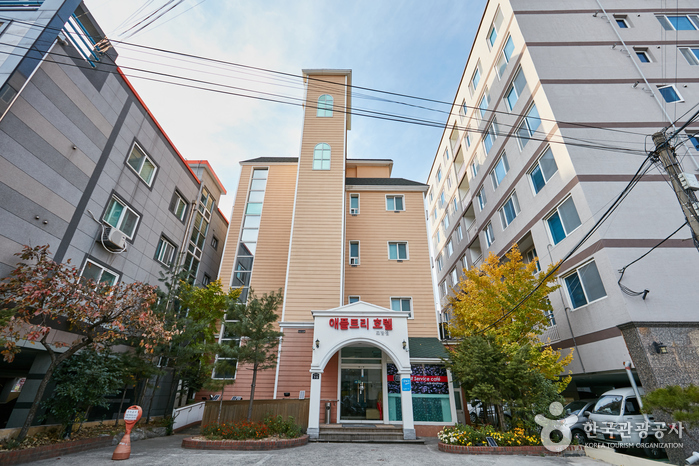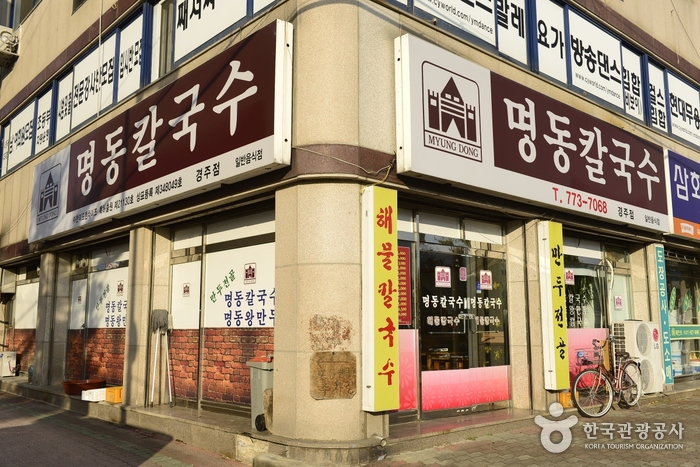Ecole confucianiste Oksanseowon [Patrimoine Mondial de l'UNESCO] (옥산서원)
0m 20657 2020-12-04
216-27 Oksanseowon-gil Angang-eup Gyeongju-si Gyeongbuk
+82-54-779-6100
L'école confucianiste de Gyeongju (monument historique n ° 525) a été construit pour commémorer les réalisations scientifiques et les vertus du confucianiste Yi Eon-jeok (1491-1553). Construit en 1572 dans la cinquième année du règne du roi Seonjo, l'école a été nommé Oksanseowon la septième année du règne du roi. L'académie est entouré par les montagnes Jaoksan, Dodeoksan, Hwagaesan, et Muhaksan. L'académie abrite 4111 livres de 866 types, y compris la Samguk Sagi (Histoire des Trois Royaumes).
Hyangdan [Korea Quality] / 향단 [한국관광 품질인증]
8.1 Km 42643 2020-09-08
121-83, Yangdongmaeul-gil, Gangdong-myeon, Gyeongju-si, Gyeongsangbuk-do
+82-10-6689-3575
Hyangdan House (Treasure No. 412) is located in the famous village of Yangdong (Gyeongju City), which has been designated as National Folklore Cultural Heritage No. 189 and recognized as a Historic Village of Korea, and consequently listed as a UNESCO World Heritage Site. The head houses of the Gyeongju Son clan and the Yeogang Yi clan are situated in this traditional village, along with typical hanok houses of Joseon noblemen and the thatched houses of commoners. Among the houses in the village, Hyangdang House stands out as it is located around Mulbong Hill. The house was built in 1540 by King Jungjong (r. 1506-1544) for the mother of Yi Eon-jeok (pen-name: Hoejae, 1491-1553). It originally measured 99-kan (a unit of measurement referring to the distance between two columns), but part of the house was destroyed during the Korean War (1950-53), leaving only 56-kan of the original structure. Hyangdan House was built in close harmony with nature, so its structure is distinct from that of other hanok houses. As it was built on a slope, the x_heights of its various structures differ considerably. For instance, the daemungan (gate building) of the haengrangchae (servants’ quarters) was built by placing the foundation stones on the incline and then building the gate on top of them. In particular, there are no staircases leading up to the main gate at the front, but there is a side door adjacent to the gate through which one can enter the house. In addition, the sarangchae (men’s quarters) located behind the haengrangchae on the higher ground can be reached via the staircases. The other structures, such as the kitchen, anchae (women’s quarters), and geonneonbang (a room opposite the main living room) are located at different levels, protecting them from exposure to the outside. Therefore, thanks to the high position of the house, it is luminous and commands an excellent view. Furthermore, the anchae is situated in the middle of the house, which enables the occupants to reach the rest of the house easily. The anbang (main living room) connects to the daecheong (main floored room) toward the south. Hyangdan House runs a variety of experience programs such as a woodblock printing program in which participants can write a letter using woodblock printing on hanji (traditional Korean paper handmade from mulberry tree); a traditional etiquette program including the wearing of hanbok (traditional Korean clothes); a tea ceremony with lotus tea; and a natural dyeing program in which participants learn how to use natural materials to dye fabric (bag, clothes, etc.). It is recommended to book the desired experience program when reserving a room at the guesthouse. The house comprises four guestrooms in the anchae, three rooms in the additional building (busokchae), and two rooms in the haengrangchae, all of which are often fully booked.
Village Traditionnel Yangdong [Patrimoine mondial de l'UNESCO] (경주 양동마을)
8.2 Km 18816 2023-01-13
134, Yangdongmaeul-gil, Gangdong-myeon, Gyeongju-si, Gyeongsangbuk-do
+82-54-762-2630
Le Village Traditionnel Yangdong à Gyeongju est le plus grand village traditionnel de Corée, affichant la culture de la Dynastie de Joseon et la beauté naturelle des environs. Grâce à ses nombreux héritages culturels, incluant des trésors, des trésors nationaux et des matériaux folkloriques, le village entier fut désigné en tant que site d’héritage culturel. De nombreuses personnes ont visité ce village pour voir la profusion de ces derniers ainsi que ses environs pittoresques. Le Prince Charles l’a visité en 1993.
Le mont Seolchangsan et ses quatre pics peuvent être aperçus derrière le village. Approximativement 160 maisons anciennes, et des maisonnettes aux toits de chaume de 500 ans d’âge sont nichées au sein de la vallée. 54 de ces maisons ont plus de 200 ans et ont été excellement préservées dans leur état d’origine, offrant une rare opportunité de voir en personne une variété de maisons traditionnelles coréennes.
Robot Life Museum (로보라이프 뮤지엄)
14.5 Km 1244 2019-03-26
39 Jigok-ro, Nam-gu, Pohang-si, Gyeongsangbuk-do
+82-54-279-0427
Le musée Robot Life Museum est situé au rez-de-chaussée de l’institut de recherche coréen sur la robotique. Il abrite une exposition et un hall d’activités sur l’intelligence robotique, un hall promotionnel KIRO, un café robot et une salle d’éducation sur l’intelligence robotique. Les visiteurs peuvent y découvrir la manière dont l’intelligence artificielle peut améliorer les logements de demain, ainsi que le futur de l’environnement robotique. De nombreuses activités permettent aux visiteurs de découvrir les nombreuses fonctionnalités des robots d’aujourd’hui et de demain.
Terminal de Bus Interurbain Pohang
16.5 Km 41387 2016-05-27
579-13 Sangdo-dong Pohang-si ongsangbuk-do
Appletree Hotel
16.8 Km 17634 2021-04-09
7-5, Jungheung-ro 100beon-gil, Nam-gu, Pohang-si, Gyeongsangbuk-do
+82-54-241-1234
Apple Tree Hotel is a business hotel located in Pohang, Gyeongsangbuk-do. It's a five-story building with a total of 28 Double, Twin, and Ondol Rooms. Non-smoking rooms are available, and free breakfast is served from 7:00am to 9:00am. The hotel is a mere 5-minute walk from Pohang Bus Terminal and only a 10-minute ride from Pohang Airport. Nearby tourist attractions include Guryongpo and Homigot Sunrise Square. The most famous dish in Pohang is "Guryongpo Guamaegi,” which is half-dried mackerel pike or herring.
Centre artistique de Gyeongju (경주예술의전당)
17.1 Km 1483 2021-02-19
1, Alcheonbuk-ro, Gyeongju-si, Gyeongsangbuk-do
+82-1588-4925
Le centre artistique a ouvert ses portes au public le 6 novembre 2010 après deux ans et quatre mois de construction, qui a commencé le 14 avril 2008. Se dressant sur un terrain d’une surface de 27 925 m², le bâtiment de cinq étages possède également deux étages inférieurs (soit l’équivalent de 13 étages en hauteur), sur une surface de 21 232 m² et équipé des derniers équipements (tels que les scènes tournantes).
Les équipements principaux incluent une grande et une petite salle de spectacle, une salle d’exposition, une scène en extérieur, une salle de conférence, une salle de séminaire et une librairie de jouet où une large gamme de programmes éducatifs et participatifs sont organisés.
Pohang Traditional Culture Center [Korea Quality] / 포항전통문화체험관 [한국관광 품질인증]
17.1 Km 5884 2020-12-12
7, Deokdongmunhwa-gil Gibuk-myeon, Buk-gu, Pohang-si, Gyeongsangbuk-do
+82-54-280-9371~3
Located in Deokdong Village about 40 minutes from downtown Pohang, the Pohang Traditional Culture Center consists of three traditional Korean buildings -- 'Lodge Building,' 'Cultural Training Hall,' and 'Food Experience Hall' -- and 'Guestroom Building' forming the shape of 'ㄱ' on an 8,251m² area. The hills surrounding the center create a cozy environment, and a grove of pine and fir trees right past the entrance adds to the beautiful natural landscape. Thanks to the clean air, you will be able to see stars in the night sky. The site originally belonged to an elementary school before being transformed into a cultural center as part of Pohang City's urban project. The center is managed and maintained by Pohang City Facilities Management Corporation as commissioned by Pohang City. As a place for learning and appreciating Korean culture in the natural landscape of Deokdong Village, which has a long history, it's now a popular field trip destination among schools. The Center offers various educational and character building programs designed to restore the traditional culture of Korea by providing students with an opportunity to learn their culture, including 'seodang (private village school that provided elementary education during the Goryeo and Joseon dynasties),' calligraphy, tea drinking, and ecosystem classes. Other programs include 'nanta (Korean traditional percussion instrument),' 'taekkyeon (traditional Korean martial art),' straw and Korean paper handicraft, and natural dyeing classes. The most popular program at the center is the traditional cooking class wherein participants get to make and try various traditional food items such as bean curd and rice cake. It's popular because the teachers/instructors use traditional recipes that many people think are fun to follow. Most of these are one or two-day programs and are participated in by groups of over 20 guests. Individual guests are also welcome to sign up for the program. The Guestroom Building has 10 guestrooms, each furnished with television, refrigerator, air conditioner, dressing table, and hair dryer for the convenience of the guests. Men's and women's bathrooms and shower rooms are in a separate building because they are shared among the guests. One of the biggest advantages of staying at this center is the reasonable room rates, which are fixed regardless of season and day (whether weekday or weekend). Moreover, there is no extra charge for additional guests in each guestroom. Paid breakfast is served at the cafeteria in the 'Experience Hall.' The breakfast is reasonably priced as well, not to mention delicious.
Gare de Pohang (포항역)
17.1 Km 2043 2016-01-11
328-71 , Daljeon-ro, Buk-gu, Pohang-si, Gyeongsangbuk-do
+82-1544-7788
La gare de Pohang a ouvert ses portes en 1981 sous le nom de la gare de Botong,
et à partir du 2 avril 2015 a nommé la gare de Pohang. La gare
est prête à jouer un rôle de plaque tournante pour les lignes
du Sud de la côte Est.
Myeongdong Kalguksu (명동칼국수)
17.2 Km 4570 2020-06-12
46-4, Yongdam-ro, Gyeongju-si, Gyeongsangbuk-do
+82-54-773-7068
Myeongdong Kalguksu serves top-grade food made with the freshest ingredients. Visitors can try kalguksu and various mandu dishes in a cozy atmosphere.

![Hyangdan [Korea Quality] / 향단 [한국관광 품질인증]](http://tong.visitkorea.or.kr/cms/resource/07/2579207_image2_1.jpg)
![Village Traditionnel Yangdong [Patrimoine mondial de l'UNESCO] (경주 양동마을)](http://tong.visitkorea.or.kr/cms/resource/44/2654744_image2_1.jpg)

![Pohang Traditional Culture Center [Korea Quality] / 포항전통문화체험관 [한국관광 품질인증]](http://tong.visitkorea.or.kr/cms/resource/26/2048726_image2_1.jpg)

 Français
Français
 한국어
한국어 English
English 日本語
日本語 中文(简体)
中文(简体) Deutsch
Deutsch Español
Español Русский
Русский